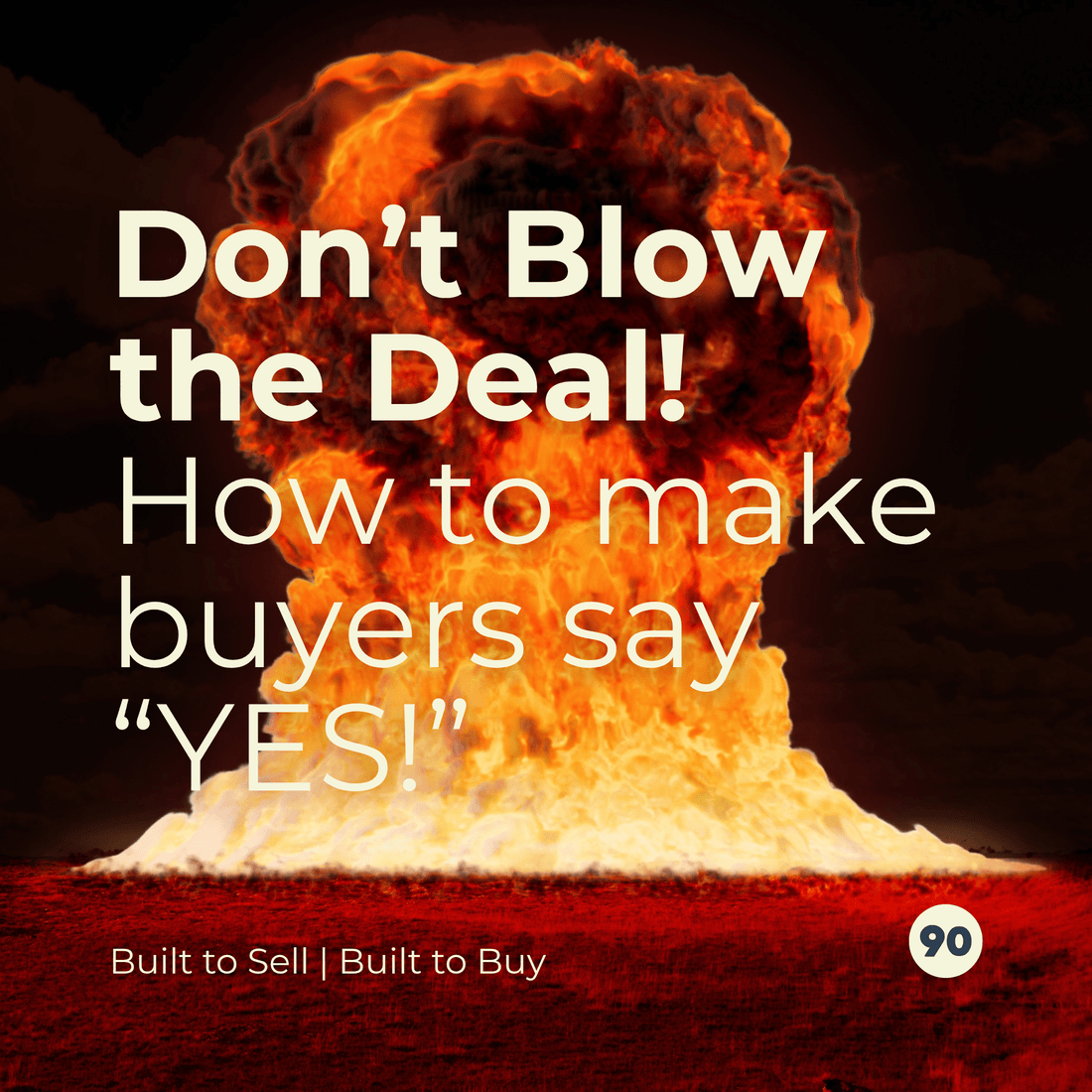
Don’t Blow the Deal: Why Your Sales Process Might Be the Real Problem (Not Your Business)
Share
You’ve spent years building your business—streamlining operations, boosting profits, cultivating a strong team, maybe even growing to seven figures. You’ve done the hard yards. So why aren’t buyers biting?
Here’s the brutal truth:
Buyers don’t just buy your business. They buy the experience of stepping into it.
And if your sales process feels reactive, vague, or disorganised?
That experience breaks confidence—fast. And no matter how solid your numbers look on paper, the buyer starts seeing risk, not opportunity.
In this post, we’re going deep on what makes or breaks a business sale—and it’s probably not what you think. Whether you're preparing to sell this year or just want to build an exit-ready business, this is the roadmap to ensure your deal doesn't die in the details.
1. It’s Not the Numbers That Kill the Deal. It’s the Process.
Most owners believe that if they tick the right boxes—strong EBITDA, clean books, growth potential—the business will sell itself.
Wrong.
Deals fall apart for far more subtle reasons:
- Sluggish response times
- Disorganised documentation
- Surprise red flags during diligence
- No clear handover or transition plan
And to the buyer, these aren’t minor oversights. They’re symptoms.
Because how you run your sale process becomes a proxy for how you run your business.
2. The 5 Stages of a Sales Process That Makes Buyers Say Yes
Want to know what serious sellers are doing differently? Here are the five stages of a sales process that builds momentum, trust, and deal confidence:
Stage 1: Pre-Market Readiness
This is the foundation. Get your:
- Clean, reconciled financials (ideally 3 years)
- Legal and operational documents
- Disclosed and itemised add-backs
- Value drivers articulated clearly
Remove ambiguity before it creeps in.
Stage 2: Go-to-Market Positioning
Your broker prepares the teaser and IM, but you must control the narrative. Frame the opportunity. Lead the buyer conversation from day one.
Stage 3: Buyer Qualification & Filtering
Not all buyers are equal. Screen the serious from the curious. Save your energy and time.
Stage 4: Due Diligence
This is where trust is confirmed—or destroyed. Be fast. Be organised. Anticipate every question.
Stage 5: Negotiation & Transition
Keep momentum alive. Set expectations. Define milestones. Create a handover that feels clean and easy.
3. Six Silent Killers That Derail the Deal
Even if your business is strong, these hidden traps can sink the deal:
- Disorganised Documentation: Chaos in reports = chaos in operations.
- Poor Response Times: Delays erode trust and raise suspicion.
- Surprise Skeletons: Undisclosed issues = instant deal breaker.
- No Transition Plan: Buyers fear being dumped in the deep end.
- Decision Fatigue: Too many choices = disengagement.
- Backchannel Whispers: Gossip from staff/customers can quietly kill the deal.
4. Your Sales Process Is Your Business in Action
Every interaction during the sale signals how the business is run. From emails to document organisation—everything tells a story.
If you’re sharp and professional, they’ll assume the business is too. If you’re vague or reactive? That story changes quickly.
5. Build a Sales Timeline (Before You Need It)
A structured timeline reduces fear and increases urgency. Here’s what to include:
- Broker Mandate: Scope, pricing, and expectations.
- Marketing Launch: Teaser and IM dates.
- EOI Deadlines: Create urgency and filter tyre-kickers.
- Diligence Window: Set a timeframe for full data access and fast replies.
- Contract & Handover Milestones: Show you’re ready and in control.
6. The Sale Toolkit Every Seller Needs
Don’t wait for buyers to ask. Have this ready:
- Clean P&Ls (3 years)
- Detailed IM
- Normalised Add-Back Schedule
- Organisational Chart
- Training & Transition Plan
- SOPs and Loom walkthroughs
- All contracts, leases, and licences
These tools build belief. They don’t just support the deal—they close it.
7. What a Great Broker *Actually* Does
A great broker isn’t a middleman. They are your:
- Strategist – to position and pitch with precision
- Shield – to manage buyer communications and emotion
- Deal Captain – to keep momentum moving until close
If your broker’s just flicking emails, it’s time for a rethink.
8. Logic Doesn’t Close Deals. Emotion Does.
Buyers justify the deal with spreadsheets. But they say “yes” when it feels right.
Create belief by:
- Sharing transformation stories
- Hosting site visits and team intros
- Letting them picture themselves taking over
Logic gets them to the table. Emotion gets them to sign.
9. What Buyers Really Mean When They Ask Questions
“Why are you selling?”
They’re wondering if something’s wrong with the business.
“Who runs things when you're away?”
They’re testing for owner-dependence.
“How long will you stay on?”
They want to know if the handover will be smooth.
“Can I speak to the team?”
They’re checking for loyalty, culture, and stability.
Have answers that reduce fear and build confidence.
Final Word: You Don’t Build a Great Sale at the Negotiation Table
It starts long before that—with structure, clarity, preparation, and control.
If you want:
- Higher offers
- Faster timelines
- Fewer lost deals
Then you need to lead like it. Be the calm, collected, sale-ready operator buyers are searching for.
Ready to Take the Next Step?
✅ Get your free Business Sale Readiness Report
✅ Book a strategy call with Sam

 Listen on Apple Podcasts
Listen on Apple Podcasts  Listen on Spotify
Listen on Spotify